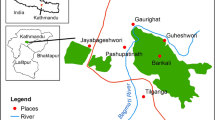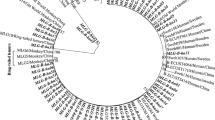Abstract
Long-tailed macaques (Macaca fascicularis) are bred in China for export and for use in experiments. Entamoeba infections in captive long-tailed macaques were surveyed in one of the biggest colonies located in Guangxi Province, China. One stool sample was obtained from each of the 152 different cages representing >3,000 macaques in the colony. The samples were examined by PCR for five Entamoeba species. The number of detected Entamoeba coli infections comprised 94% of the samples, 93% for Entamoeba chattoni, and 83% for Entamoeba dispar. In contrast, Entamoeba histolytica and Entamoeba nuttalli were not detected. Six isolates of E. dispar were obtained by culture in Tanabe–Chiba medium. Analysis of serine-rich protein genes in these isolates showed two genotypes, one of which is identical to that of the E. dispar SAW760 strain in humans. This suggests transmission of E. dispar between humans and nonhuman primates. These results demonstrate that Entamoeba infections are common, but virulent Entamoeba species are absent in this colony. This work also confirms the need for monitoring with PCR-based identification of Entamoeba species for captive macaques in breeding colonies to ensure animal health and protection of humans from zoonotic hazards.


Similar content being viewed by others
References
Clark CG, Kaffashian F, Tawari B, Windsor JJ, Twigg-Flesner A, Davies-Morel MCG, Blessmann J, Ebert F, Peschel B, Van AL, Jackson CJ, Macfarlane L, Tannich E (2006) New insights into the phylogeny of Entamoeba species provided by analysis of four new small subunit rRNA genes. Int J Syst Evol Microbiol 56:2235–2239
Diamond LS, Clark CG (1993) A redescription of Entamoeba histolytica Schaudinn, 1903 (Emended Walker, 1911) separating it from Entamoeba dispar Brumpt, 1925. J Eukaryot Microbiol 40:340–344
Fan Z, Song Y (2003) Chinese primate status and primate captive breeding for biomedical research in China. In: National Research Council (ed) International perspectives: the future of nonhuman primate resources. National Academic Press, Washington. Proceedings of the workshop held 17–19 April 2002, pp 36–45
Ghandour AM, Zahid NZ, Banaja AA, Kamal KB, Bouq AI (1995) Zoonotic intestinal parasites of hamadryas baboons Papio hamadryas in the western and northern regions of Saudi Arabia. J Trop Med Hyg 98:431–439
Ghosh S, Frisardi M, Ramirez-Avila L, Descoteaux S, Sturm-Ramirez K, Newton-Sanchez OA, Santos-Preciado JI, Ganguly C, Lohia A, Reed S, Samuelson J (2000) Molecular epidemiology of Entamoeba spp.: evidence of a bottleneck (demographic sweep) and transcontinental spread of diploid parasites. J Clin Microbiol 38:3815–3821
Haghighi A, Rasti S, Mojarad EN, Kazemi B, Bandehpour M, Nochi Z, Hooshyar H, Rezaian M (2008) Entamoeba dispar: genetic diversity of Iranian isolates based on serine-rich Entamoeba dispar protein gene. Pak J Biol Sci 11:2613–2618
Levecke B, Dreesen L, Dorny P, Verweij JJ, Vercammen F, Casaert S, Vercruysse J, Geldhof P (2010) Molecular identification of Entamoeba spp. in captive nonhuman primates. J Clin Microbiol 48:2988–2990
Muriuki SM, Murugu RK, Munene E, Karere GM, Chai DC (1998) Some gastro-intestinal parasites of zoonotic (public health) importance commonly observed in old world non-human primates in Kenya. Acta Trop 71:73–82
Rivera WL, Kanbara H (1999) Detection of Entamoeba dispar DNA in macaque feces by polymerase chain reaction. Parasitol Res 85:493–495
Rivera WL, Yason JA, Adao DE (2010) Entamoeba histolytica and E. dispar infections in captive macaques (Macaca fascicularis) in the Philippines. Primates 51:69–74
Stensvold CR, Lebbad M, Victory EL, Verweij JJ, Tannich E, Alfellani M, Legarraga P, Clark CG (2011) Increased sampling reveals novel lineages of Entamoeba: consequences of genetic diversity and host specificity for taxonomy and molecular detection. Protist (in press)
Suzuki J, Kobayashi S, Murata R, Yanagawa Y, Takeuchi T (2007) Profiles of a pathogenic Entamoeba histolytica-like variant with variations in the nucleotide sequence of the small subunit ribosomal RNA isolated from a primate (de brazza's guenon). J Zoo Wildl Med 38:471–474
Tachibana H, Cheng XJ, Kobayashi S, Fujita Y, Udono T (2000) Entamoeba dispar, but not E. histolytica, detected in a colony of chimpanzees in Japan. Parasitol Res 86:537–541
Tachibana H, Cheng XJ, Kobayashi S, Matsubayashi N, Gotoh S, Matsubayashi K (2001) High prevalence of infection with Entamoeba dispar, but not E. histolytica, in captive macaques. Parasitol Res 87:14–17
Tachibana H, Yanagi T, Pandey K, Cheng XJ, Kobayashi S, Sherchand JB, Kanbara H (2007) An Entamoeba sp. strain isolated from rhesus monkey is virulent but genetically different from Entamoeba histolytica. Mol Biochem Parasitol 153:107–114
Tachibana H, Yanagi T, Akatsuka A, Kobayashi S, Kanbara H, Tsutsumi V (2009) Isolation and characterization of a potentially virulent species Entamoeba nuttalli from captive Japanese macaques. Parasitology 136:1169–1177
Takano J, Narita T, Tachibana H, Shimizu T, Komatsubara H, Terao K, Fujimoto K (2005) Entamoeba histolytica and Entamoeba dispar infections in cynomolgus monkeys imported into Japan for research. Parasitol Res 97:255–257
Takano J, Narita T, Tachibana H, Terao K, Fujimoto K (2007) Comparison of Entamoeba histolytica DNA isolated from a cynomolgus monkey with human isolates. Parasitol Res 101:539–546
Takano J, Tachibana H, Kato M, Narita T, Yanagi T, Yasutomi Y, Fujimoto K (2009) DNA characterization of simian Entamoeba histolytica-like strains to differentiate them from Entamoeba histolytica. Parasitol Res 105:929–937
Verweij JJ, Polderman AM, Clark CG (2001) Genetic variation among human isolates of uninucleated cyst-producing Entamoeba species. J Clin Microbiol 39:1644–1646
Walsh JA (1986) Problems in recognition and diagnosis of amebiasis: estimation of the global magnitude of morbidity and mortality. Rev Infect Dis 8:228–238
Yoshimura M, Ebukuro M (1988) A modified Tanabe–Chiba medium for detection of Entamoeba histolytica. Jikken Dobutsu 37:321–324
Zaki M, Meelu P, Sun W, Clark CG (2002) Simultaneous differentiation and typing of Entamoeba histolytica and Entamoeba dispar. J Clin Microbiol 40:1271–1276
Acknowledgments
This work was supported by a grant (to XC) from the National Science Foundation of China (Grant No. 30771878), a grant (to QX) from the National Science Foundation of China (Grant No. 30760281), and Grant-in-Aid for Scientific Research (20590431) from the Japanese Society for the Promotion of Science (to HT).
Author information
Authors and Affiliations
Corresponding author
Additional information
Nucleotide sequence data reported in the paper are available in the DDBJ/EMBL/GenBank databases under accession numbers AB583701 and AB605349.
Rights and permissions
About this article
Cite this article
Feng, M., Yang, B., Yang, L. et al. High prevalence of Entamoeba infections in captive long-tailed macaques in China. Parasitol Res 109, 1093–1097 (2011). https://doi.org/10.1007/s00436-011-2351-2
Received:
Accepted:
Published:
Issue Date:
DOI: https://doi.org/10.1007/s00436-011-2351-2




